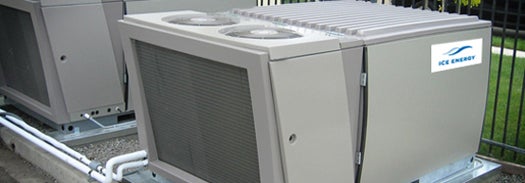California Utilities to Store Off-Peak Power In Blocks of Ice
It seems like a perennial story in the Golden State: the temperatures go up, air conditioners across the state kick...

It seems like a perennial story in the Golden State: the temperatures go up, air conditioners across the state kick into high gear and power utilities simply can’t keep up. Now, a group of Southern California utilities plans to combat the state’s searing summers with ice, building a 53-megawatt distributed energy storage project that will lock away off-peak cooling power for use during the sweltering mid-day peak.
During those peak consumption hours — generally from noon to 6 p.m. — the albatross around the neck of power utilities is air conditioning units, which all tend to kick on more or less at the same time as daytime temperatures rise. To keep these consumption spikes from overpowering the generators and transmission lines, the utilities will deploy Ice Energy’s Ice Bear — winner of a PopSci Best Of What’s New award in 2007 — across a 7,000-square-mile service area, attaching the units to 1,500 commercial and rooftop air conditioners to help offset the burden.
The Ice Bear works by freezing 450 gallons in an insulated tank during the night, when energy consumption is at its lowest. A series of copper coils running through the tank pumps in enough coolant to turn the water to ice, where it remains until temperatures begin to rise during the day. When the AC begins its daily struggle to cool the building the Ice Bear kicks in, pumping the AC’s warm refrigerant through the copper coils in the ice, cooling it without employing the AC’s energy intensive compressor.
When the ice is completely melted, usually about six hours later, the AC kicks back into normal operation, but by then peak demand has passed and the AC coasts into the cooler evening hours with less power consumption. The Ice Bear begins freezing the melted water in its tank, and the process starts again.
As a concept there’s no miracle science here, just an innovative means to store cheaper, more abundant off-peak electricity in ice blocks for use during the most taxing part of the day. Ice Energy claims that during peak hours its units can reduce the AC energy burden by 95%, certainly a tall order during hot SoCal summers. But even if those claims fall short, it seems intuitive that the technology could significantly reduce the energy burden of commercial AC during peak demand, and at the very least extend the life of AC units by keeping compressors from running all day.
The Southern California Public Power Authority plans to roll out the Ice Bears over the next two years, so we’ll see just how well it works soon enough. In the meantime, you can check out the Ice Bear in here.
[Ice Energy via Miller-McCune]